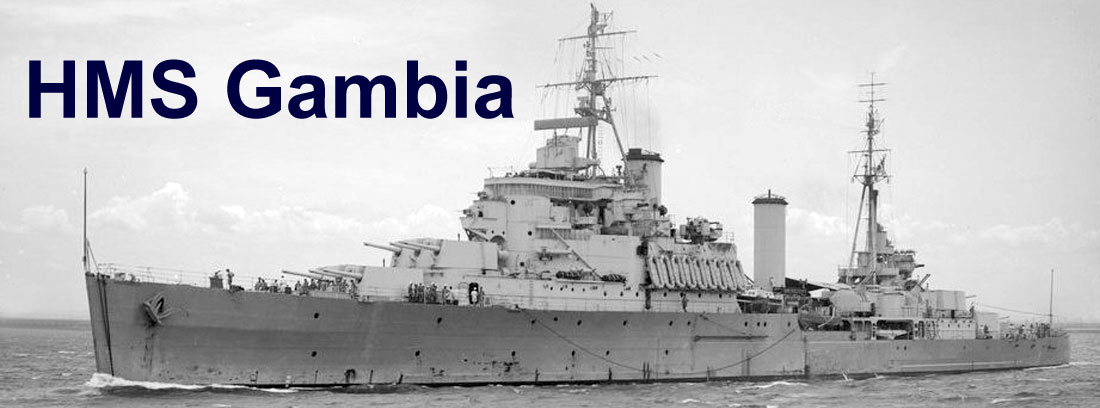
The Huddersfield Connection
Warship Weeks
The Royal Navy paid a terrible price during WWII, losing 50,758 men killed in action, 820 missing in action and 14,663 wounded in action. They also lost 278 major warships and more than 1,000 smaller ones. Money had to be found to build more ships and so at the end of 1941 and into 1942, Warship Weeks were introduced. People could buy various types of Bonds such as War Bonds, Savings Bonds, Defence Bonds and Savings Certificates. Cash could be donated at post offices and banks.
Communities were given a target to reach, the larger the community, the more they were expected to contribute and the larger the ship and crew they could adopt. Glasgow for example would go on to adopt the battleship HMS Duke of York, Leeds would adopt the aircraft carrier HMS Ark Royal. Smaller communities would be expected to contribute smaller sums, so that places such as the parish of Mildenhall in Suffolk would go on to raise £74,697 6s 9d. and adopt a trawler minesweeper, HMS Macbeth.
There were a total of 1,178 warship weeks organised during the campaign, involving a total of 1,273 districts. The total amount raised was astonishing, £955,611,589. In 2019, that would be worth £44,651,828,680!
Huddersfield's Warship Week
Huddersfield lies in the triangle formed by Leeds in the north, Manchester to the southwest and Sheffield to the southeast in West Yorkshire. It has a population of a little over 160,000. It is in what is now Kirklees, a local government district of West Yorkshire.
In 1942, Vice-Admiral Arthur L. Snagge performed the opening ceremony of the town's Warship Week. He appealed for £14 million for a cruiser and emphasised that and shipping is "more important today than ever they were."
Hinchliffe Mill Industrial Co-operative Society invested £1,000 in 3% war loan bonds in the local Warship Week and in March 1942, Huddersfield adopted HMS Gambia after collecting £1.5 million. Smaller towns in what is now Kirklees adopted other ships; Colne Valley (minsweeper HMS Kellett), Heckmondwike (corvette HMS Genista), Holmfirth (destroyer HMS Hero), Kirkburton (minesweeper HMS Hussar), Meltham (minesweeper HMS Mazurka), Mirfield (corvette HMS Coreopsis), and Spenborough (destroyer HMS Airedale).
Huddersfield and HMS Gambia
And so began the relationship between Huddersfield and HMS Gambia. The people of Huddersfield not only collected the money to adopt the ship but would also occasionally send the crew small gifts which were doubtless welcomed throughout the war. The crew for their part sent money backto Huddersfield so the poorer children of the town could go to Christmas pantomimes or take small breaks.
The Admiralty present each community a plaque. This is the one that was presented to Huddersfield and is displayed in the Town Hall...
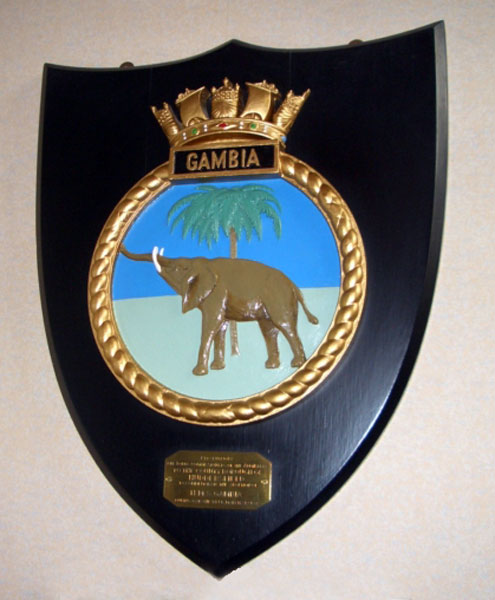
Huddersfield's HMS Gambia Plaque
Photo by Gordon Hodgson
The inscription reads:
Presented by
the Lords Commissioners of the Admiralty
to the County Borough of
Huddersfield
to commemorate the adoption of
H.M.S. Gambia
during Warship Week March 21st 1942
The Huddersfield Examiner recorded a lot of the interactions between the town and the ship and allowed Bill Hartland to reprint the articles on the orginal HMS Gambia website and which are reproduced here.
H.M.S. Gambia Comes Home - July 28, 1952
A welcome home letter has gone from the Mayor of Huddersfield to Captain L.F. Durnford-Slater, R.N., and Ship's Company of Huddersfields adopted ship, H.M.S. Gambia, due to return to Devonport, her home base, on Thursday, after two-and-half-years on foreign commission. H.M.S. Gambia has been in the thick of the eventful happenings in the Mediterranean area during her commission.
At the time of the Persian oil flare-up Gambia was in the Persian Gulf, and when, in October of last year, large scale rioting broke out in the Canal Zone, Gambia, then on her way to the East Indies, put in to Port Said to roll up her sleeves and get to work on the berthing and slipping scheme by which the Navy kept the world's shipping going on its short-cut route to and from the East.
Cock O' The Fleet
After five weeks of combined mooring crew duties, police work and stevedoring, Gambia weighed anchor and steamed for Malta, and after returning to Port Said for Christmas finally steamed for the East Indies in January 1952. There she took part in joint exercises with the Indian and Pakistani Navies. While on her commission H.M.S. Gambia has worn the flag of every flag officer of the Mediterranean Fleet, including that of R.A.B. Edwards.
Rear Admiral Edwards commanded Gambia as her former Captain, in the Far East in 1945, and it was under his command that the ship claims to have fired the last shot in the war. When Gambia steams into Devonport on Thursday she will be wearing the pendant which distinguishes her as "Cock o' the Fleet," as winner of the recently held Mediterranean Fleet Pulling Regatta.
Huddersfield Windfall From "Adopted" Ship
Give Treat For Children, Town Council Told - December 3, 1952
A Windfall of £218 4s. 7d. has been received by the Children Committee of the Town Council. It's the balance of the welfare fund of H.M.S. Gambia ("adopted" by Huddersfield during the war) on the paying off of the ship's company, and with the cheque was a request that the money be devoted to the provision of an additional treat for children under the care of the committee.
A short time ago the Children Committee received, through the Mayor, a cheque for £35 from the ship's company, which made a total of £140 given by the sailors for the children since 1948. The thanks of the Committee have been sent to the Officers and Men, and the Children's Officer has been instructed to make enquiries regarding the possibility of the older children being taken for an extra weeks holiday at the sea-side and the the younger children, and those unable to travel, being given an alternative treat.
September 23, 1958.
H.M.S Gambia, the cruiser adopted by Huddersfield when, on March 20, 1942, the town raised £1.5 Million, in War Weapons Week, berthed at Chatham last Friday after completing her latest commission as the flagship of the last British Naval Commander-in-Chief, East Indies Station.
On board Gambia was Musician Selwyn Horner of the ship's Royal Marine Band, whose parents, Mr and Mrs Fred Horner, live at Dalton. Mr and Mrs Horner, and members of their family, were welcomed with other relatives of the Officers and Men aboard, where, after looking round the ship's quarters, they were presented with a beautifully produced book - H.M.S. Gambia, 1957-58 - which records the ship's activities since May 1, 1957. Mr and Mrs Horner, have decided that the book should be available to the town, and yesterday it was presented to the Mayor and Mayoress, to be preserved as a link between the Gambia and Huddersfield.
We Joined The Navy - For Three Days
Five school boys could not have been more excited than the Huddersfield party as they boarded H.M.S Gambia at Rosyth, and the same scholboys could not be more thrilled when we came alongside 600 miles later at Portsmouth. By then the link between Huddersfield and H.M.S. Gambia - forged in 1942 when, during Warships Week, Huddersfield raised an amount sufficient to "Adopt" the Gambia - had been strengthened, and there was the promise that the exchanges will be more frequent than in the past seventeen years.
Making the voyage at the invitation of Capt. W.J. Munn were the Mayor (Ald J. L. Brook), the Deputy Mayor (Ald R.H. Browne and Clr. F. Lawton), along with the Mayor's Secretary (Mr. W. Stoney), and also aboard were the Provost of Dunfermline (Mr. Archibald Frederick) and the Town Clerk (Mr. John Douglas).
Towering Above Us
The first impression was of the hugeness of the Gambia. It is a cruiser of the Fiji Class, 8,000 tons displacement, 555ft long with a complement of 586 officers and men. As we crossed the gangway the masts packed with radar and wireless equipment, the bridge and the armament on the various decks seemed to tower above us. The main fire power is nine 6in., eight 4in. and eighteen 40mm. guns.
The ferry-boat on which we had crossed the river seemed as insignificant against the Gambia as did a train against the mighty Forth Bridge. On the first evening aboard the civic party dined with the Captain. Gambia was described to us by one officer as a ship not up to modern standards, but by our expectations of the austerity of life at sea it was of four star RAC standard. Each of us was granted the comfort and privacy of our own cabin, with the Mayor accommodated in the opulence of the quarters reserved for the Admiral, and we were accorded the full hospitality of the wardroom.
VIP Treatment
The Mayoral party were given VIP treatment throughout the trip, and those who have experenced Navy hospitality and courtesy will know the wealth of meaning there is in this statement. The brilliance of the weather on the evening of arrival at Rosyth was only a sample of what was to be enjoyed for the remainder of the trip. The last minute discussion among the guests on retiring just before midnight (sorry, 23.59 hours) was whether Ald Browne or Clr. Lawton should take the middle watch, but, fortunately for the peace of mind of all, the Navy said that they could manage.
"Let go forrard, let go aft," were the commands the following morning. The tugs Impetus and Energy took the strain, and slowly the Gambia inched her way to the middle of the river.
TV Pictures
Messages were flashed to and from the shore, thanks sent to the tugs "for your help while coming and going from Rosyth," and the Gambia - setting out for a tour of duty in the Mediterranean - said goodbye to her home port for the last twelve months. Before she left, a TV cameraman took pictures of the civic parties and then of the ship sailing under the Forth Bridge for use on Scottish television that evening.
The pleasure of viewing the sights of the Firth of Forth was enhanced by the commentary given to the Mayoral party by their Scottish colleagues on points of interest. Friends have since asked, " How did you spend your time?" There was never a dull or unoccupied moment? always something new -to us - to see, someone to question on this or that item of the ship, on the routine, or where we were at the time.
There was the testing, towards the mouth of the Firth, of a repaired propellor shaft by a speed trial which worked up gradually to twenty-eight knots. At this speed the bow wave was an impressive sight, and at the stern the appearance was as if someone below were boiling up a million packets of detergent. On the way aft we stopped to watch the traditional Naval ceremony, the Rum Issue.
Lined up with their cans were the delegates of the various messes. Under the watchful eye of the Officer of the Watch and a representative of "other ranks," the amount for the day was diluted two parts water to one of rum in the huge rum tub bearing the brass letter inscription, "The Queen, God Bless Her." What did astonish the visitors was that when all the due tots had been ladled out into the respective mess cans the pint or two left over was unceremoniously tipped over the side into the sea. Caught unawares the first day, the visitors passed the word the second day so that not all of the remains went overboard.
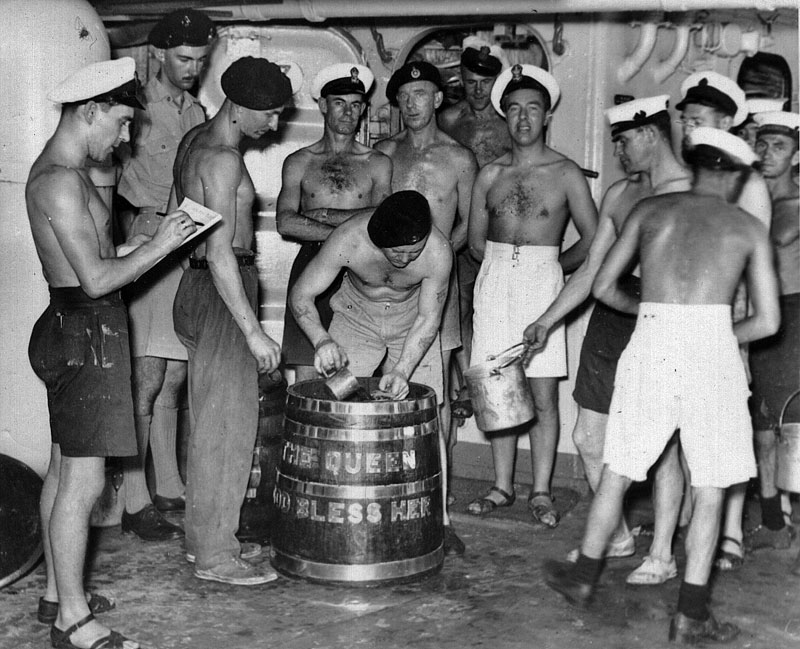
Rum issue in 1952. The rum ration was stopped on July 31, 1970. Photo from my dad's albums.
The whole of the first days sailing - in brilliant sunshine and in water as smooth as on Blackmoor reservoir - was done as near to the coast as possible mostly at two or three miles, and the ship's officers were always ready to indicate points of interest such as the Bass Rock (a bird sanctuary) and the Farne Islands. Off Berwick the Gambia stopped for whaler crews of six to take off and practice for a regatta in which they are to compete when they reach the Mediterranean. At the same time three divers went over the side to inspect the propellor and shaft.
Clay pigeon shooting was another recreation - when the "clays" could be found. At the appointed hour the officer in charge waited with his party of riflemen and pitchers. Ten minutes past the time and the rating dispatched for the "clays" had still not returned. Twenty minutes, twenty five minutes . . . and then half an hour overdue, he arrived, panting, and with the amusing explanation that he had searched in every conceivable place and only by chance had eventually traced them to the cookhouse store. They had ben placed there by someone with either a fine sense of humour or else an aptitude for a too literal interpretation of instructions. The container bore the words, "Fragile, treat as eggs!"
On The Bridge
There was a fascination about the bridge, a place of continued activity day and night, and the origin of unending instructions and announcements to all parts of the ship. In the mass of readings, observations and bearings taken from an array of charts and dials and commands given, one reailsed that it was the co-ordination point, the very nerve centre, of the Gambia's progress.
The Mayor's obvious good spirits and wit engendered in the ship's company an inclination to good humoured chaffing when occasion befitted. The best instance of this occured on the second evening at sea. As we were seated at dinner in the wardroom the officer on the bridge announced over the loud-speaker system, "We are now entering Yorkshire Territorial Waters." The Mayor led the cheering of the Huddersfield party at this news. The loud-speaker system, by the way, penetrates to every room and compartment on the ship.
Twinkling Lights
The lights of Whitby, and then Scarborough, twinkled prettily as we took our last stroll on deck that evening. Though the sun again shone unclouded, a sea mist about three miles away kept from us a sight of land for the whole of the second day. This was obviously the time for a visit to the radar room, where one could appreciate how land and shipping hazards are clearly defined at night and in fog. We were able to "see" other shipping at distances of up to sixty miles.
Then to the boiler and engine rooms and a realisation of the hot, noisy and often cramped conditions with which those engaged on that deck have to contend. Statistics: The Gambia develops 85,000 h.p. on her four shafts, carries 1,600 tons of fuel oil, and makes 16,000 gallons of water a day for all-purpose use onboard.
Journey's End
The last hours aboard were packed with ships and landmarks to see - the Goodwin Lightships, the white cliffs of Dover, the Dover Patrol Memorial, the beauty spots of the Isle of Wight, the increase of shipping, submarines and frigates passing close to us, then Southsea and the knowledge that our voyage was nearly over.
Saluting parties were standing smartly at attention on all decks, everyone was dressed in No. 1's in preperation for going ashore, a gun salute from the Gambia greeted Portsmouth, signals were hoisted, and we were hauled by cables and pushed by tugs alongside. Big as we had thought the Gambia, it was dwarfed by the battleship Vanguard and an aircraft-carrier berthed not far away.
Gift to Huddesfield
There was one last ceremony on the third morning before the Huddersfield party said goodbye to Capt. Munn, Lt - Cmdr, R.H. Ellis and other Gambia personnel. Lined up on the quarter-deck were the ship's welfare committee, consisting of representatives of all ranks. Each was introduced by the Captain to the Mayor, who was then presented on behalf of the whole ship with a cheque for £21 "for some childrens cause in Huddersfield." "We have had this association with your borough since 1942," said Capt. Munn, "and the ship's company are very keen that it should continue. They, in turn, wish to 'adopt' some children's cause in Huddersfield and have asked me to present this cheque as a first contribution."
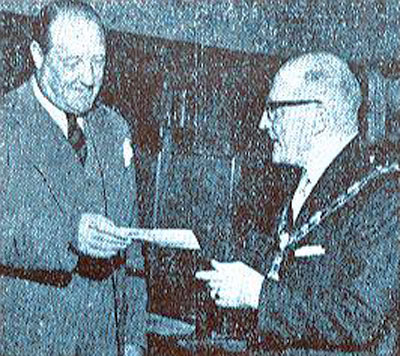
Captain Mann handing over a cheque for £21 to the mayor of Huddersfield, Alderman J. L. Brook
In reply the Mayor said, "From first joining your ship we have received a welcome so warm that it has overwhelmed us. Huddersfield adopted H.M.S. Gambia, but it seems to me that you have adopted us. This gift indicates your desire for a closer relationship between the town and your ship. We are glad of and grateful for this." The Mayor then presented to the Captain a plaque bearing the Huddersfield coat-of-arms.
Provision for Cyclone Isle - February 29 1960
Half the houses in Port Louis, capital of Mauritius, are estimated to have been badly damaged or destroyed by the cyclone which hit the island on saturday night and raged for fourteen hours. Announcing this today, a Colonial Office spokesman said that the Albion Dock and the railway station were also badly damaged. It was probable that similar destruction had been caused in other urban areas. Ten people are reported to have died.
Huddersfield's adopted ship, the cruiser Gambia, sailed "with all dispatch" from Trincomalee (Ceylon), last night for Mauritius carrying provisions and medical supplies. News of the disaster - the cyclone was the worst to hit the island since 1892 - was received in London yesterday while a deputation of Ministers from Mauritius were here to seek financial aid after last months cyclone.
A Colonial Office statement last night said that subject to Parliamentary approval it was intended to announce government grants and loans totalling £2m. In view of the second disaster, the Government were giving "urgent consideration" in consultation with the Mauritius Government to what further measures of financial assistance might be needed. The British Red Cross and St. John Ambulance Brigade have already offered aid.
Death Roll Rising
A later report from Port Louis said that the death roll was now about sixteen and was expected to be much higher. Thousands were homeless. The Mauritius Government delegation spent forty minutes with Mr. Macleod (Colonial Secretary) this morning, and afterwards a Colonial Office spokesman said that preliminary arrangements were in hand for the dispatch of British experts to assess the amount of damage caused by the second cyclone.
Arrangements had been completed to ensure a supply of repair materials such as corrugated iron, nails and copper wire as soon as requirements were known. Arrangements were also in hand for sending field kitchens, clothing, blankets and essential supplies. British Red Cross headquarters said that they were packing 2,000 blankets, fifty dozen babies' nappies and underwear to be sent to Mauritius. The WVS were providing about five tons of clothing, numbering about 20,000 items.
Youth Forum: Gambia Trophies for Sea Cadets - October 14 1960.
The Mayor (Ald. Norman Day) along with officers and cadets of Huddersfiled's Sea Cadet Corps Unit, have a"VIP" appointment at Liverpol on December 1, aboard H.M.S. Gambia, the town's war-time adopted cruiser. Very soon H.M.S. Gambia will be joining the Royal Navy's "mothball" fleet, but before she sets sail on her paying off voyage, her skipper (Capt. W.J. Munn) and his ship's company are anxious that two of their trophies should be handed over to the safekeeping of the Sea Cadet Unit in the town with which the warship has had such happy associations during her commission.
Plaque and Cup
The trophies are an oak plaque, bearing a silver silhouette of the vessel, presented to the ship's company by the people of the Colony of Gambia ten years ago, and a silver cup, the gift of the Mayor, Corporation and townspeople of Huddersfield. In a letter to Lt. S. G. Sykes, commanding officer of the local Sea Cadets, Capt. Munn writes that H.M.S. Gambia will be calling at Liverpool from November 29 to December 5 during her autumn cruise.
Capt. Munn points out that when a Royal Navy ship goes into reserve, what usually happens is that her trophies are carefully hoarded in a barrack store until such time as she is re-commissioned or another vessel of the same name joins the Fleet. In this instance, however, it is the wish of the Gambia's crew that the liaison that has existed between themselves and Huddersfiled should be maintained.
The Governor of Gambia has given his blessing to the idea of presenting the plaque to the Sea Cadets and a message from him will be read out at the handover ceremony. Similarly, the Mayor and Corporation of Huddersfield have concurred that it will be "most appropriate" if, in future, the silver cup is held by the Cadets as a trophy to be competed for in the sphere of training or sport.
"Very thrilled" Capt. Munn goes on to write, "I would like to hold the presentation during the ship's stay at Liverpool and have invited the Mayor to present the cup himself." "I sincerely hope that as many of your instructors and cadets as possible will be present at the ceremony."
Lt. Sykes told me this week that his cadet ship's company are "very thrilled" about the invitation and the purport of it. As yet, it was too early to state how many cadets would visit H.M.S. Gambia, but there would probably be a good represenation, including a representative of the civilian committee. The Mayor and Sea Cadet party have been invited to dine after the ceremony at the Captain's table.
Never Dies
While it was, perhaps a melancholy thought that the time was fast approaching when Gambia might well be sailing the seas no more, a ship never dies. Its tradition lived on in the hearts and minds of all who had sailed in her and got to know her. She is well remembered by the H.M.S. Gambia Associaion.
I do not know when the following article was published.

Huddersfield's wartime link with HMS Gambia
Along with Brian Hughes were association members Geoff Stevens and Cliff Hewitt
The text says:
Huddersfield people are re-forging links with a World War Two Royal Navy ship the town adopted. HMS Gambia was one of several colony class cruisers built with money raised from National Savings. The Government held a Ships Week in which people were encouraged to buy National Savings Bonds to help raise money for the wartime fleet. The Gambia was named after one of Britain's colonies, but was twinned with Huddersfield.
Brian Hughes of Mirfield, is the chairman of The Gambia Association, made up of about 100 of its ex-servicemen. The men and their wives hold reunions in different parts of the country twice a year. The association last night presented a replica of a plaque which was on the bridge of their ship to Huddersfield Sea Cadets. The real plaque was presented to the people of Huddersfield when the ship was scrapped in 1968. It now hangs in Huddersfield Town Hall.
The Gambia was built by Swan Hunter at Wallsend-on-Tyne, between 1938 and 1942. It took part in the occupation of Madagascar in September 1942. The following year it was loaned to the New Zealand Navy and fought in the Far East. In 1945 it came back to Britain, where it was refitted and brought back into service.
Mr. Hughes joined the ship in 1950 at the age of 18 and completed two years' National Service as a galley chef. He said: "At that time, the Gambia served in the Home Fleet – so we spent our time patrolling the Channel. People don't realize just what it was to be in the navy and those 16 or 18 men became closer than brothers," he said. "You slept in the same place, ate in the same place, had your recreation in there and worked together in the galley."
Mr. Hughes was a founder member of the association in 1989 and welcomed former servicemen to Huddersfield for a reunion in 1995. He is also a member of the Sea Cadets' civilian committee. The plaque was presented to the Sea Cadets at its meeting at Snow Island. The Sea Cadets already own a silver trophy which was originally presented to the ship by the people of Gambia, when it paid them a visit in 1954. It has a picture of the Gambia engraved on the side.
On the ship's earlier visit to Gambia on its way home from duties in 1943, West African chiefs in full regalia led thousands of people to see it. Mr. Hughes borrowed the trophy for one of his association's reunions. In return he agreed to present it to the best watch of Sea Cadets each year. Mr. Hughes had the replica plaque made as he renovated the original plaque. The association welcomes ex-Gambia sailors to join in its activities. Mr. Hughes particularly wants to hear from anyone who knows Brian Leese, who used to work in the bookings office at Huddersfield Railway Station. He served on The Gambia alongside him in the galley.
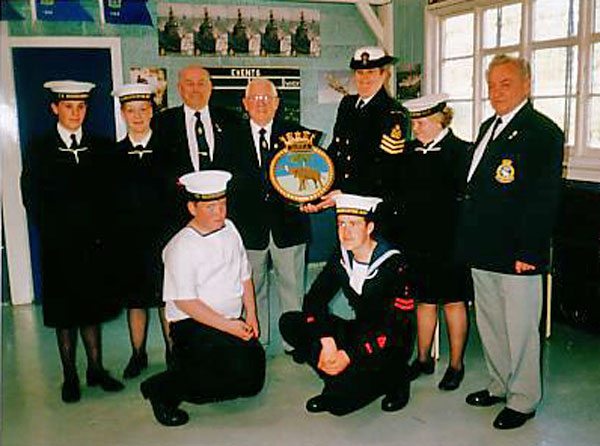
Presenting Huddersfield Sea Cadets with the HMS Gambia plaque. HMS Gambia Association members Brian Hughes, Geoff Stevens and Cliff Hewitt
The following comes from the Huddersfield Examiner article "Nostalgia: Huddersfield's warship HMS Gambia" published on November 9, 2011...
HMS Gambia was mothballed in Portsmouth in 1960. Huddersfield Sea Cadets were given two mementoes from the ship at the time: an oak plaque which had been presented to the ship by the people of Gambia six years earlier and a silver cup, which had been a gift from Huddersfield Borough Council.
One beneficiary of the crew's reciprocal generosity was Stephen Carter, who was a resident of the Huddersfield Borough's childrens homes from 1951 to 1961. "We were lucky enough to get extra treats thanks to the crew of HMS Gambia," he said. "They would hold fundraising events so that we could go on panto trips or extra holidays to the seaside - Colwyn Bay was one such extra holiday. We had the chance to visit the ship when it docked at Hull, I think in the early to mid-1950s. We travelled by train and had a fish and chip meal before running riot round the ship. I bet the crew were glad when we had gone home."
I do not know when HMS Gambia was in Hull but the people of Huddersfield had another chance to visit the ship at the end of her working life. HMS Gambia was in Liverpool from November 29 to December 5, 1960 and had an open day on Sunday, December 4.

HMS Gambia at Liverpool on Sunday, December 4, 1960. Photo by Roger Bratby
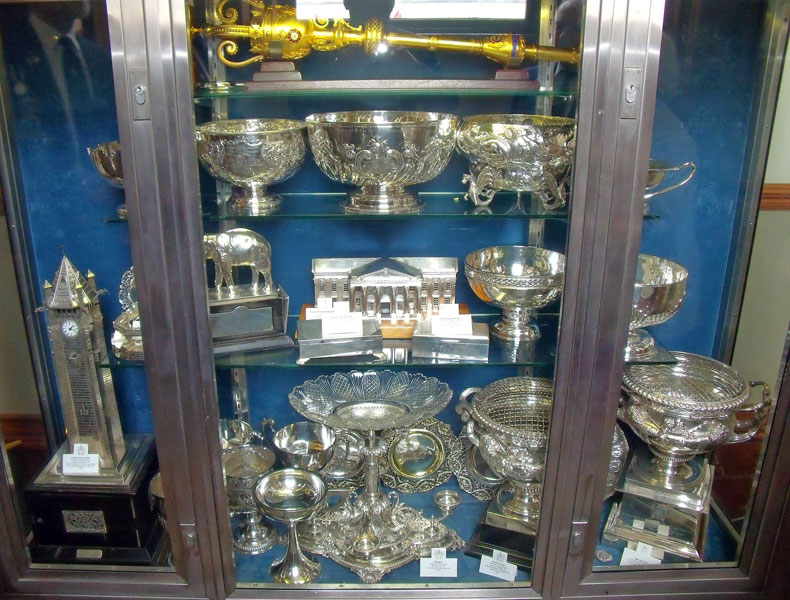
Huddersfield's civic silver collection
This photo was taken by Bill Hartland on the 70th anniversary of Warship Week on September 23, 2012
The following thumbnails are to main images that appear to have jumped ship and gone AWOL. Bill had a lot of images on his website, unfortunately all that could be retrieved from the Web Archive were the thumbnails. Until the original photographs can be found, they are simply presented here. The HMS Gambia Association held its AGM in 1995 in Hudderfield and these thumbnails appear to be from that. The original photos were contributed by Frank Farmer and Margaret Hughes, wife of the past chairman Brian Hughes.
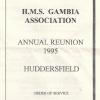 HMS Gambia Association AGM program
HMS Gambia Association AGM program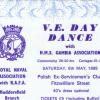 An invitation to a VE Day Dance
An invitation to a VE Day Dance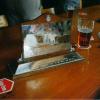 HMS Gambia silver plaque
HMS Gambia silver plaque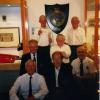 HMS Gambia Association - Under the plaque
HMS Gambia Association - Under the plaque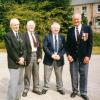 HMS Gambia Association officers
HMS Gambia Association officers HMS Gambia Association group photo
HMS Gambia Association group photo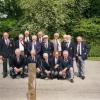 HMS Gambia Association group photo
HMS Gambia Association group photo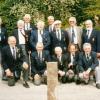 HMS Gambia Association group photo
HMS Gambia Association group photo HMS Gambia Association group photo
HMS Gambia Association group photo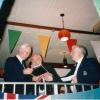 HMS Gambia Association at the Polish Club
HMS Gambia Association at the Polish Club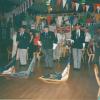 HMS Gambia Association standard bearers at the Polish club
HMS Gambia Association standard bearers at the Polish club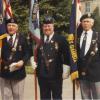 HMS Gambia Association - A trio of standards
HMS Gambia Association - A trio of standards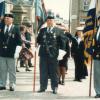 HMS Gambia Association standard bearers
HMS Gambia Association standard bearers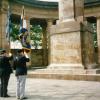 HMS Gambia Association at the War Memorial
HMS Gambia Association at the War Memorial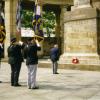 HMS Gambia Association at the War Memorial
HMS Gambia Association at the War Memorial Service of Rememberance
Service of Rememberance HMS Gambia Association at the Tolston Museum
HMS Gambia Association at the Tolston MuseumSources
1942 - Warship Week
British Naval Warships and Their Adopters
Hinchliffe Mill Co-Op Resume
HMS Duke of York
HMS Gambia, later HMNZS
Huddersfield Town Hall, 'H.M.S. Gambia'
Huddersfield's bit to Help War Effort Recalled
List of Royal Navy losses in World War II (Wikipedia)
Naval History of World War II (Wikipedia)
Nostalgia: Huddersfield's Warship HMS Gambia
Welcome to Huddersfield! Visitors' Book Signatures